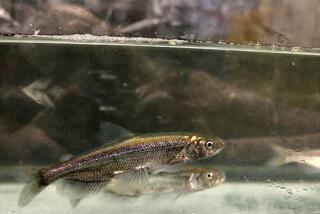Federal Biologist Stands by Original Assessment of Delta Smelt Status : Environment: The Fish and Wildlife Service overruled his finding that the species is endangered, not merely threatened. He says he was not pressured.
- Share via
SACRAMENTO — As the U.S. Fish and Wildlife Service proposed Friday that the delta smelt be listed as merely a “threatened” species, the biologist who led the investigation into its plight stood by his original finding that the small fish warrants a higher level of protection.
Gail Kopetich, assistant field supervisor of the Fish and Wildlife Service office here, said he still believes the delta smelt population has declined to such a low level that it warrants the greater protections given to species designated as “endangered.”
The decision to propose the less severe listing of threatened was made by Kopetich’s superiors in Washington and at the Western regional headquarters in Portland. He would not have changed his position if he had been asked to, Kopetich said.
With Friday’s announcement, the Fish and Wildlife Service, along with state agencies, will embark on a yearlong study of the delta smelt and the reasons for its decline. If the study shows the smelt is a threatened species, measures then would be taken to ensure its survival.
Regardless of the level of protection given the fish, efforts to save it are likely to affect how California’s water system is run, and may result in cuts in water shipments from the Sacramento-San Joaquin River Delta to California’s major population centers and farms.
Kopetich’s statements were praised by environmentalists who have contended that Fish and Wildlife’s decision to recommend the more limited threatened status for the delta smelt was influenced by the divisive politics of water in California.
“You don’t often see a federal bureaucrat stand up and take a position like this,” said Mike Sherwood, attorney for the Sierra Club Legal Defense Fund, which had advocated a designation of endangered for the fish.
In an Aug. 1 memo, Richard Smith, deputy director of the Fish and Wildlife Service in Washington, said he had concluded the smelt population was stable, and that it should be designated as threatened.
He directed that Marvin Plenert, Western regional director, revise his stand that the fish should be deemed endangered. Plenert complied. Kopetich said Plenert did not ask him to revise his own position, adding: “He simply didn’t want to put pressure on us.”
Kopetich said outside pressures did not affect his findings. He said he believes his supervisors based their decision on data showing the smelt population, though 90% below what it once was, has been stable for five years.
Kopetich, a 27-year veteran of the federal government, said he was not disappointed that his recommendation was overruled. In Washington, Fish and Wildlife press officer Georgia Parham said the difference arose from varying interpretations of the same biological data.
“It is not unusual for biologists to come to different conclusions based on the same information,” she said.
All the debate is over a fish that grows to no more than three inches, lives only a year and has no commercial value or recreational use. Modest though the smelt may be, Kopetich and other scientists believe its decline mirrors the failing health of the delta, the only waters where it lives. Many environmentalists believe that if the fish can be saved, the largest delta on the Pacific Coast would recover too.
Under the Endangered Species Act, an endangered species is one facing impending extinction. A threatened species is one likely to become endangered within the foreseeable future. Regardless of whether the fish is found to be threatened or endangered, the act requires that Fish and Wildlife come up with a plan to help it recover.
Kopetich said the higher classification of endangered could result in tougher measures to ensure the smelt’s survival. One effect of the difference under its designation as threatened could be that more delta smelt could be killed legally by huge water project pumps, Kopetich said. Additionally, the amount of water that could be pumped might be greater.
In its statement announcing its decision, the Fish and Wildlife Service said probable causes of the drop of the smelt population include water exports from the delta, the drought and the effects of pollution. Another cause of its decline may be that a small clam introduced into the delta from Asia is eating the smelt’s favorite food, a particular kind of plankton.
Fish and Wildlife is proposing that almost the entire delta--the waters, as well as the food and other factors the fish needs to survive--be deemed the smelt’s “critical habitat.”
More to Read
Sign up for Essential California
The most important California stories and recommendations in your inbox every morning.
You may occasionally receive promotional content from the Los Angeles Times.













